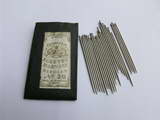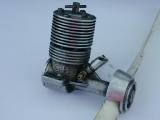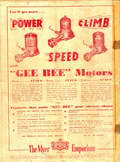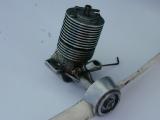| Name | GB50 Diesel | Designer | Gordon Burford |
| Type | Compression Ignition | Capacity | 5cc |
| Production run | approx 1400 | Country of Origin | Australia |
| Photo by | Ron C | Year of manufacture | 1949/50 |
Background
Gordon Burford is Australia's most well known and prolific engine designer and builder. The engine pictured here is one of his first mass produced engines. Chronologically, it fits between the "Drone" (aka GB Stuntmota) style engines and the first Sabre. Appearance wise, it bears features of the English Yulon series in the "beehive" shape of the head and finning above and below the exhaust ports. However, the Yulons (29, 30 and 49) all used "updraft" intakes and nearly all had a series of small diameter holes for the exhaust. The GB50 has more conventional down-draft intake and slotted exhaust. The liner is secured to the case with four short round head screws (look closely in the exhaust band). The head is then secured with four long screws spaced between the short ones. The backplate has two holes in its rim to accommodate a "pin" spanner, unlike Gordon's later engines which used the more conventional "penny" slot arrangement. It's also worth noting that Gordon always referred to his early motors as "GB". The Gee Bee moniker came from the advertising of his somewhat unethical agent and resulted in the name change to Sabre, but that's another, longer, sadder story.
Construction
There is quite a story behind the origin of the needles used on GB, Sabre and early Taipan engines too. Here it is, courtesy of David Owen:Producing the needle itself for a needle valve was never easy in the early days. Before the advent of sliding head autos, lathes generally lacked the high spindle speeds needed to turn a taper on a small diameter, and grinding tapers on hardened wire resulted in unacceptable wheel wear. Ready-made gramophone needles looked like a good idea, but their short length precluded use in all but the smallest engines.
 These problems faced Gordon Burford when he started to build engines in the late 1940s. His solution was to use readily-available quilting needles. The taper on a quilting needle was not exactly ideal for a needle valve and these were eventually replaced with more suitably shaped Diamond brand No. 3/0 egg-eyed harness needles, made in England by John James and Sons.
These problems faced Gordon Burford when he started to build engines in the late 1940s. His solution was to use readily-available quilting needles. The taper on a quilting needle was not exactly ideal for a needle valve and these were eventually replaced with more suitably shaped Diamond brand No. 3/0 egg-eyed harness needles, made in England by John James and Sons.
The well-known tailoring firm of Reuben F Scarf was the Australian agent for these needles. They were packaged in a small black paper folder containing two dozen pieces. Each needle was roughly 60mm long, which left plenty of length after cutting-off the eye.
As production of engines increased, Gordon asked Scarfs to supply needles without the packaging and the eye. He was quoted twice the current price for those changes. Ultimately, needles were purchased in bulk, being supplied in lots of 10,000, tightly packed in a soldered, tinplate box roughly 12"x9"x4" in size. The eyes were still intact.
Scarfs never told John James and Sons about the ultimate use of the needles. Did they wonder if there was a revival of horse-drawn transport Down-under?
The Australian Customs people were also taking an interest in needles. Gordon Burford held one of only two Customs Determinations in South Australia, which entitled him as an OEM to import the needles through Scarfs without the imposition of Sales Tax. Was he selling needles to horsey types tax-free? A subsequent investigation cleared him. Pilkington Glass held the other Determination on single-edged razor blades, which were used to finish plate glass.
Finally, in the early '60s, the egg-eyed harness needles were replaced by turned needles, as Gordon Burford and Co were now able to produce them on their own modern machinery.
Conclusion
The venturi in this example has been assembled 180 degrees back to front--it should actually be oriented to face into the slipstream. The engine pictured is exactly as the current owner found it at a Flea Market stall! This is one of those genuine cases where a rare and collectable engine was purchased for a song, and even then the buyer hesitated not knowing what he was getting. Read it and weep.
![]()



